Art Fairs
From an Animatronic Gorilla to a Beaded Glass Cage—Here’s What Was Stealing the Scene at Art Basel Unlimited
Ambitious projects by Ryan Gander, Christo, Kader Attia, and Liza Lou had VIPs talking.
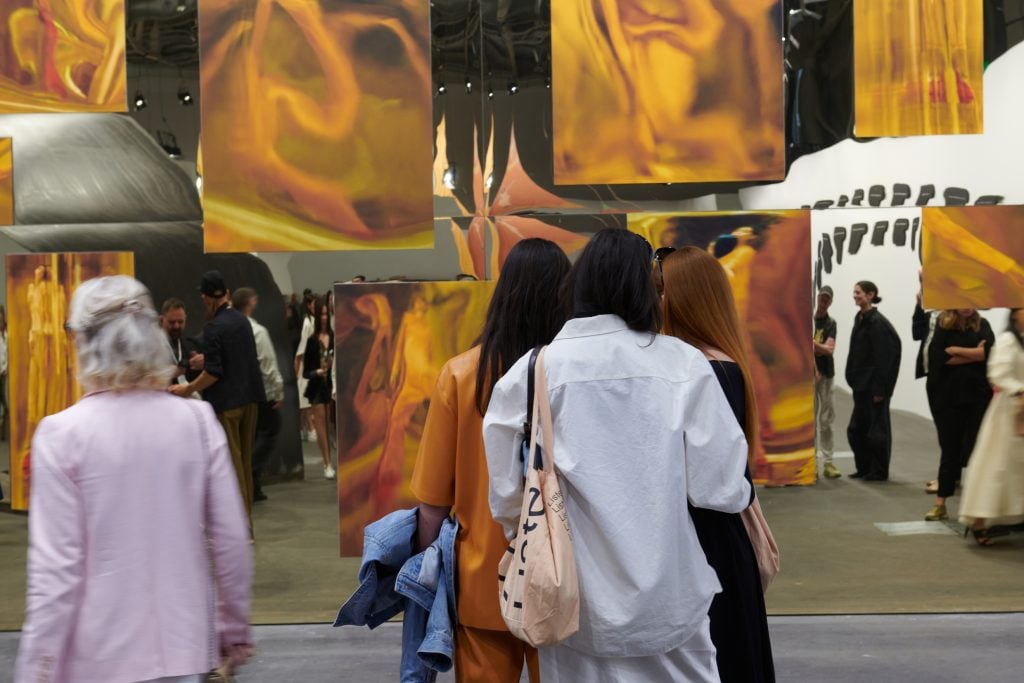
Ambitious projects by Ryan Gander, Christo, Kader Attia, and Liza Lou had VIPs talking.

Naomi Rea

You know Art Basel has begun when the posting starts.
On Monday afternoon at Unlimited, the sector for works too spectacular to be shown in a normal art fair booth, museum directors and art collectors hurried through a germinating wheat field on the Messeplatz—an installation by artist Agnes Denes—in a bid to be first past security. Early Instagram posts of the monumental works, interactive installations, and electric live performances in the special sector of the fair are how industry insiders like to telegraph their First Choice VIP status. The event serves as a curtain raiser for the week, allowing time for slow-looking and air-kissing before the elbows come out in the main fair’s feeding frenzy on Tuesday.
This year, Art Basel’s selection committee has tapped 70 projects from 93 galleries for the prestigious showcase curated by Giovanni Carmine, who is director of the Kunst Halle Sankt Gallen, a museum in a Swiss hamlet which is as famous for its bratwurst as it is for being the hometown of mega-dealer Iwan Wirth.
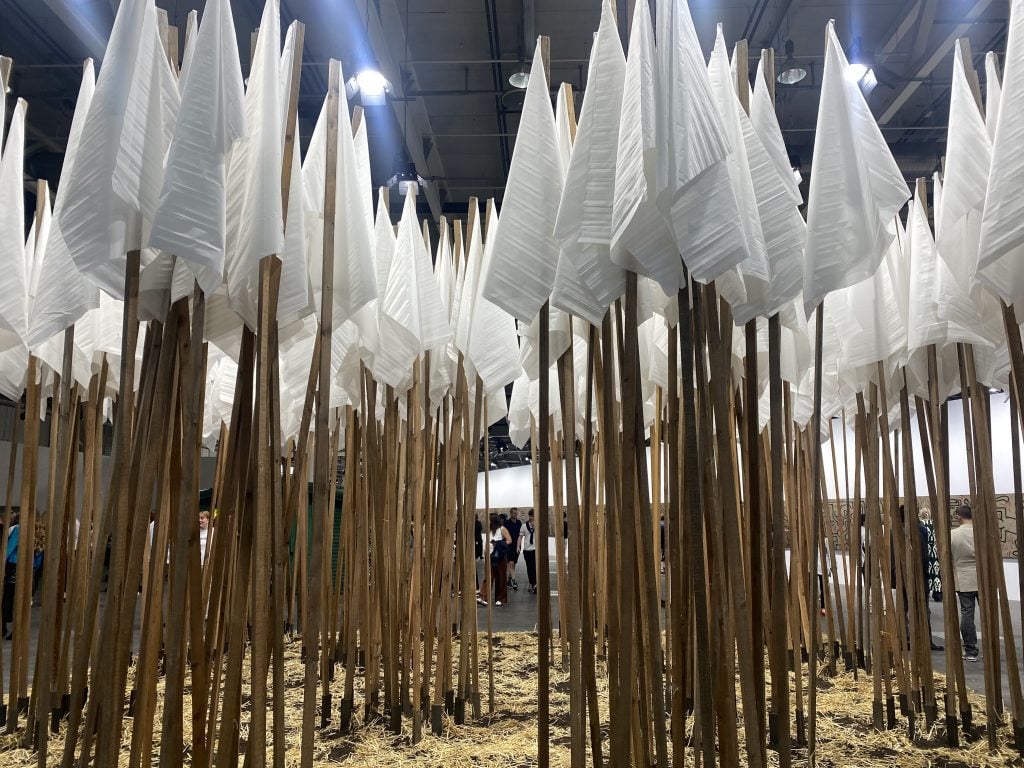
Mario Ceroli, Progetto per la pace (1968). Photo: Naomi Rea.
The first installation the eye lands on in the cavernous hall off the Messeplatz is a series of still white flags, their stakes planted into a floor of earth and hay. The 1968 work by Mario Ceroli, titled Progetto per la pace (Project for peace) and presented by Cardi gallery, transforms this classic symbol of surrender into a (cautiously neutral) international call for peace.
Amid ongoing geopolitical instability and inflation concerns, art buyers this year are expected to continue the trend of being more “discerning,” read: tighter-fisted. That said, the outlook on the ground feels carefully optimistic. Last week, the European Central Bank lowered interest rates by 0.25 percent, the first cut in almost five years. Meanwhile, after years of exuberance, once-stratospheric asking prices seem finally to be returning to earth. “I gladly see the price expectations of the sellers starting to align with the buyer’s, and that when good things happen!” advisor Sibylle Rochat told me ahead of the fair.
Still, many of Basel’s bigger-ticket buyers are Americans, and central banks in the U.S. and the U.K. have yet to replicate the dial-back. Even then, Rochat cautioned “the market tends to react with delay and Basel is tomorrow,” adding that “what we really need is good political news to get back some human optimism.”
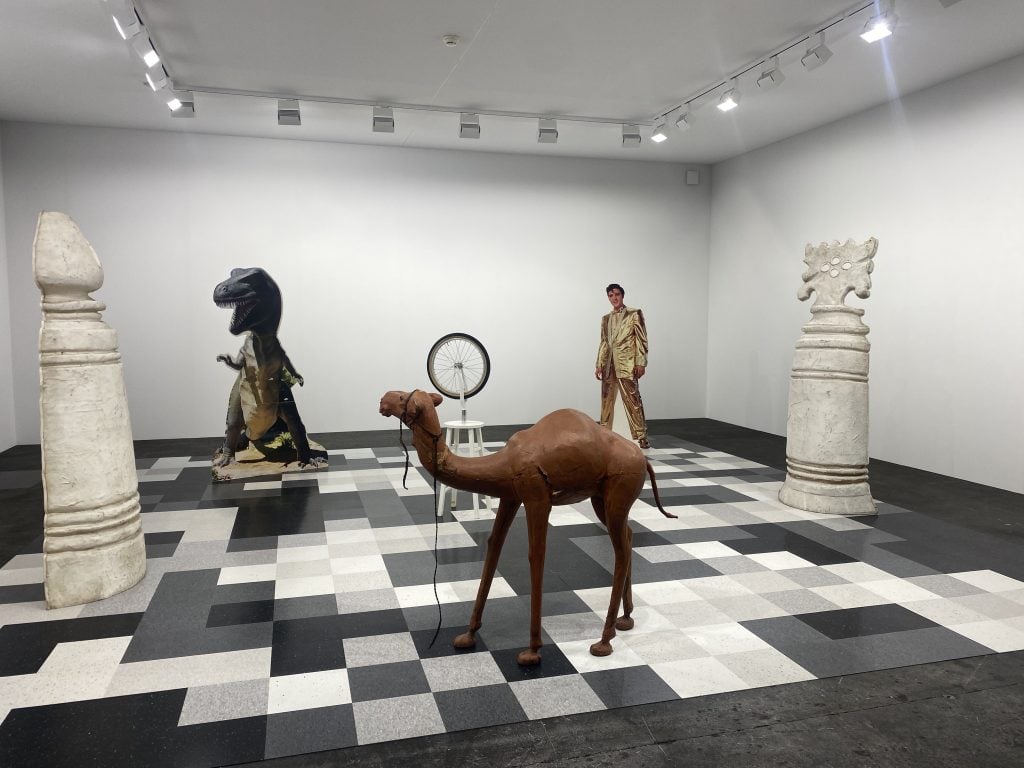
Lutz Bacher, Chess (2012). Presented by Galerie Buchholz. Photo: Naomi Rea.
It’s hard to gauge the market’s appetite as a whole at Unlimited, where the sheer scale of the works rules out the majority of buyers who are not museums or private foundations. VIPs spotted in the early moments of the fair included collectors Paul Ettlinger and Lucca Hue Williams, Frieze Masters director Nathan Clements-Gillespie, and director of the Fondation Cartier, Chris Dercon.
“It’s a different kind of collector base,” Alex Logsdail, CEO of Lisson Gallery, said. “These presentations are often just as much about showcasing the grand vision of an artist as they are about showing something one hopes to sell.”

Christo’s Wrapped 1961 Volkswagen Beetle Saloon (1961) at Gagosian. Photo courtesy of Art Basel.
For some, it is all about pizzazz, as getting those early social media tags can be a branding boost for the gallery ahead of a high-stakes week. Early Instagrammable favorites included a wooden cabin by Alex Da Corte with neon flames licking up its windows (presented by Sadie Coles HQ), the late artist Christo’s mustard-yellow Wrapped 1961 Volkswagen Beetle Saloon at Gagosian, a late-career recreation of one of his earliest wrapped works, carrying an asking price of $4 million. Elsewhere, Martin Margiela has erected a faux fur stage for Bernier/Eliades gallery, and Lutz Bacher has set up an irreverent chess game populated with 20th-century icons, from Elvis Presley to the T.Rex.
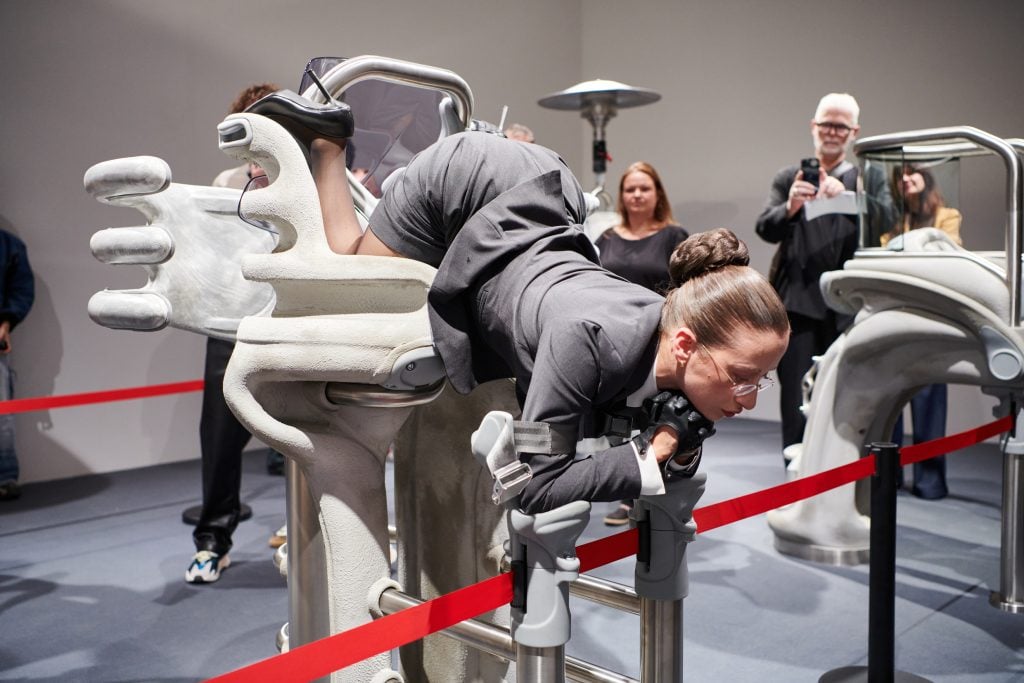
Anna Uddenberg. Kraupa Tuskany Zeidler, Meredith Rosen Gallery. Courtesy of Art Basel.
In the fair’s early moments, viewers were transfixed by performers activating Swedish artist Anna Uddenberg’s sculptural installation Premium Economy, shown jointly by Meredith Rosen Gallery and Kraupa-Tuskany Zeidler. Its title evoking the oxymoronic moniker for the class of transit in which many of us arrived to Basel just hours ago (that is, those of us who did not fly in on private jets), it involved a cohort of neatly dressed business women in pencil skirts and kitten heels mounting pseudo-functional chairs and prostrating themselves, posteriors risen towards the sky. A performance of the piece at Meredith Rosen Gallery in New York went viral on TikTok last year, and as performers ushered visitors in reverent silence through the installation, it was clear that Uddenberg’s submissive figures were bent on dominating the attention economy.
Priced at €180,000, Uddenberg’s installation comes with a script for the performers should the owner wish to activate it. “The performers have to be trained to enter/exit the sculptures,” Rosen explained, adding that it’s important that the cast: “can serve bad bitch energy.”
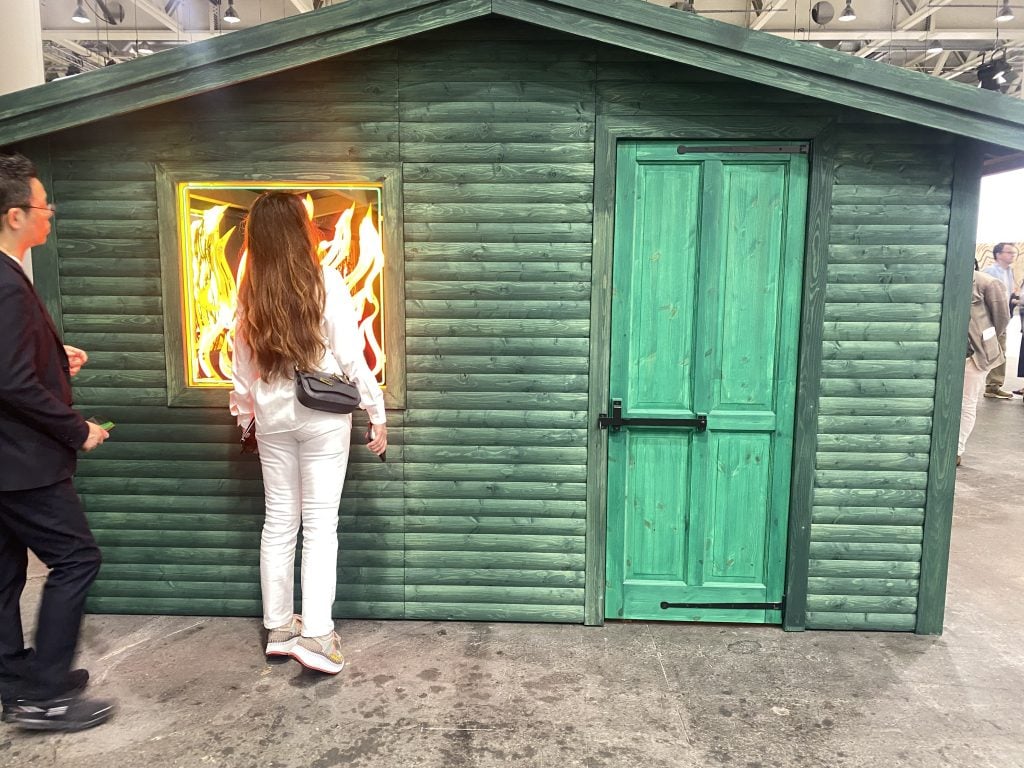
Alex Da Corte, Hell Hole (2022). Photo: Naomi Rea.
At Lisson, viewers clustered by a sublimely backlit watercolor paper screen by Hiroshi Sugimoto (asking price $900,000). But attracting more attention was Ryan Gander’s decidedly less aesthetic animatronic gorilla, huddled beneath an office desk amid an aroma of urine being blown about by a standing fan. Averting the gaze of the viewer, the primate was attempting to count on her fingers. Called School of Languages (2022), Gander informed me that she is trying to master the language of numeracy.
“Numbers are probably the greatest disease to humankind,” the artist explained: Counting up conjures associations of accumulation, accelerated capitalism, greed, and excess, and counting down is just as bad, creating a different sense of anxiety, one that reminds us of our own mortality.
Was it ironic then to be showing such a work (priced at £500,000) at Art Basel, the site of a tremendous exchange of capital?
“For me, art isn’t a capital exchange. Art is an exchange of dreams, and conversations, and ideas,” Gander said.
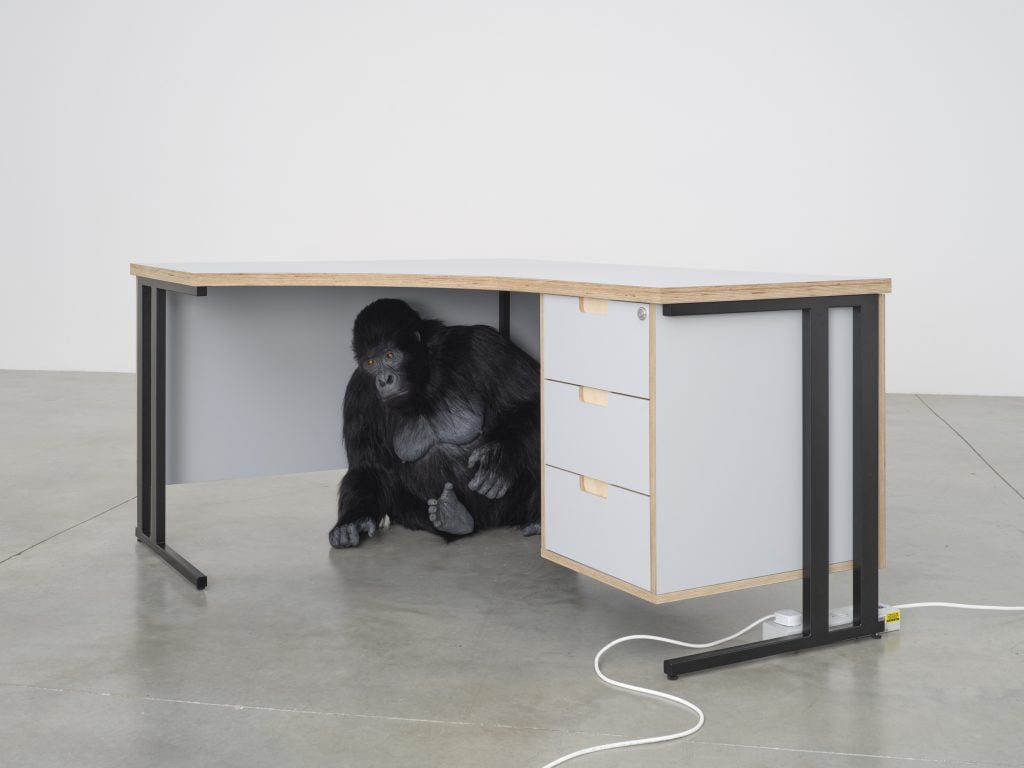
Ryan Gander, School of Languages (2023). ©Ryan Gander, courtesy Lisson Gallery.
Some of Gander’s other animatronic works have taken off on the Internet post-lockdown. Asked what it is about his work that captures the public eye, he said: “I think things that attract our attention now are things that don’t look like art. If it’s a conventional sign and you understand its position in the world—i.e. this is a sculpture, made by an artist, being sold by a gallery—we see an artwork first, we don’t see the thing that is being sculpted. I’m more interested in how natural signs… like footprints in the snow, a gorilla hiding under a desk, could exist in the world of art.”
Gander puts his finger on what is so exciting about this sector of the commercial event; it seems to leave more room for ideas than the clusters of paintings in the convention hall which for many have become nothing more than two-dimensional dollar-signs.
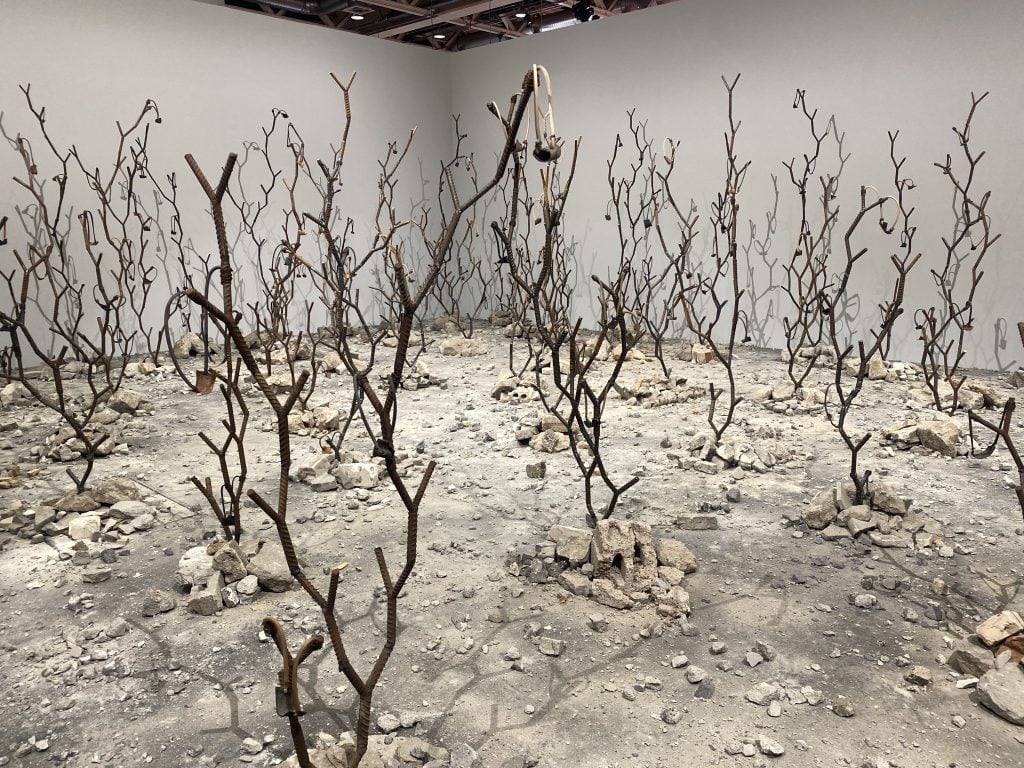
Kader Attia, Intifada: The Endless Rhizomes of Revolution (2016). Photo: Naomi Rea.
At Nagel-Draxler, artist Kader Attia was showing an anti-war work from 2016. A forest of leafless trees of iron rebar emerged from piles of rubble, slingshots bound to their bifurcated branches. Titled Intifada: The Endless Rhizomes of Revolution the makeshift weapons recall those used by Palestinians against Israelis during the First Intifada in 1987, in protest against Israel’s occupation of the West Bank and the Gaza Strip.
It feels daring to show such a work in this sensitive news climate. Not to be misconstrued, the artist clarified its intent: “It is an artwork about the history of violence and the agency of resistance as a form of existence, and does not call for violence in any form,” Attia said.
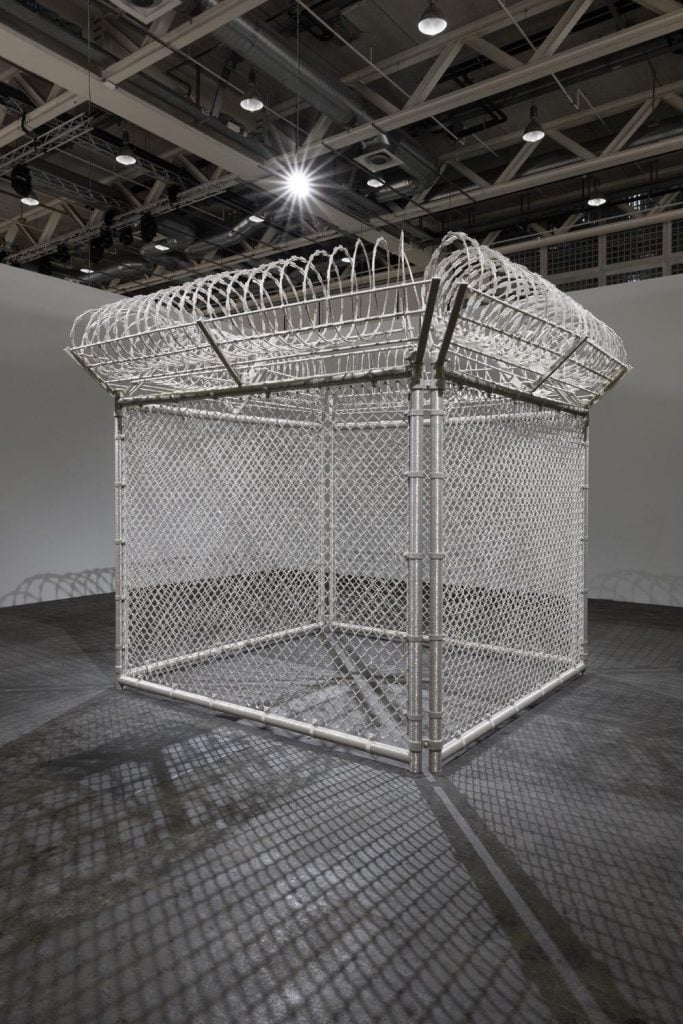
Liza Lou, Security Fence [detail] (2005). Photo: Naomi Rea.
Oscillating between solemnity and irreverence, today’s curtain-raiser sets the stage for an interesting week, albeit a site for transacting ideas more than Swiss Francs. Still, the week is young. While possibly the most expensive work at Unlimited just might be an exquisite 1970 Donald Judd being shown by Gagosian with an asking price “in the eight figures,” word has it David Zwirner has a Joan Mitchell “Sunflowers” work on its booth tomorrow with an $18 million ticket price. As the Basel sunshine transforms the stalks on Agnes Denes’s Messeplatz wheat field from green to gold, the question lingers: will gallerists find themselves harvesting a similar abundance by week’s end?